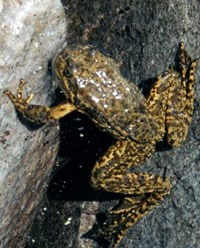
NPS Photo Staff at Sequoia and Kings Canyon National Parks have released for public comment a plan that would help restore native species in high elevation aquatic ecosystems, including selected lakes, ponds, streams and marshes found from approximately 6,000 to 12,000 feet. These ecosystems include the range of two formerly abundant native amphibian species, the Sierra Nevada yellow-legged frog (Rana sierrae) and the mountain yellow legged-frog (Rana muscosa), hereafter collectively referred to as MYLFs. Subject matter experts from inside and outside the National Park Service (NPS) have evaluated possible tools, best practices, and public comment to develop alternatives that best meet ecosystem management objectives. Purpose of and Need for the Plan This Restoration Plan/DEIS is needed to provide long-term management direction to restore and conserve the parks' high elevation aquatic species and ecosystems. This action is needed at this time:
One example of urgent conservation need is that MYLFs have disappeared from 92% of historic localities in the Sierra Nevada including the parks. Extensive research has identified two primary causal factors for this decline. First, the presence of nonnative fish prey on MYLFs, compete with them for food, restrict their breeding to marginal, shallow habitat and fragment remaining populations. Second, the recent spread of disease (chytrid fungus) has infected and imperiled most remaining MYLF populations. In addition, global climate change has begun to dry up critical MYLF breeding habitat. Because of the historic abundance of MYLFs, they are important as predators, prey, and recyclers of energy and nutrients in aquatic and adjacent terrestrial ecosystems. Therefore, the MYLFs' decline has had negative consequences to high elevation ecosystems across the Sierra Nevada. Wherever nonnative fish are eradicated, it would have beneficial effects to native species and ecosystems. Eradicating fish from waters adjacent to existing MYLF populations would not only restore native ecosystems but would also potentially prevent the extinction of these native frogs that are integral to ecosystem health. NPS Management Policies 2006 directs parks to implement feasible management actions to respond to resource threats. As park management and staff have gained a better understanding of high elevation aquatic ecosystems and potential threats to them, it was determined that a comprehensive plan is needed to evaluate and respond to harmful changes in these systems. This Restoration Plan/DEIS provides guidance for restoration and conservation of native species and high elevation aquatic ecosystems in the parks. Implementation would remove a major threat (nonnative fish) from selected ecosystems, making them more resilient to disease and climate change. Selected MYLF populations would also be treated for disease with antifungal agents to increase survival and recruitment. This strategy shows high potential to strengthen imperiled MYLF populations to overcome nonnative fish, disease and climate change. Recent Aquatic Management Actions in the Parks By 2010, fish were fully eradicated from eight lakes and nearly eradicated from three lakes, and MYLFs in nine of these lakes remained disease-free three years after fish removal. During this time average tadpole density in these nine lakes increased by 13-fold (from 2.4 to 30.8 per 100 ft of shoreline), while average frog density increased by 14-fold (from 2.4 to 33.8 per 100 ft of shoreline). Several of these MYLF populations are now among the largest in the Sierra Nevada. In addition, garter snakes were 10 times more likely to be found in fish removal lakes (versus fish-containing control lakes where no removal was conducted). This difference is likely due to the presence of increased numbers of MYLFs, which are a primary prey of garter snakes, in fishless lakes versus fish-containing lakes. These results show that using parks staff to eradicate nonnative fish using gill nets and electrofishers is feasible, and beneficial to MYLFs and other native species. By 2013, nonnative fish were eradicated from four additional lakes. Nonnative fish eradications are currently in progress in 11 additional lakes and ponds, expected for completion by 2016. The management-preferred alternative in the Restoration Plan/DEIS proposes removing nonnative fish from an additional 87 (16%) of the parks' remaining 549 high elevation lakes, ponds and marshes known to contain fish. This would keep ample opportunities available for recreational fishing in 462 waterbodies, while helping populations of MYLFs and other native species become as resilient as possible to uncertain future conditions in several selected lake basins across the parks. For more information about this project, click the links below under "Project Resources." To review and comment on the Restoration Plan/DEIS, click the link below that begins with "Aquatic EIS Project Page..." Project Resources Enabling Legislation |
Last updated: April 15, 2022
